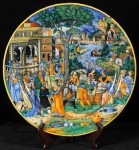 A woman in Somerset, England, discovered she had a rare Italian Renaissance Maiolica plate hanging on the wall of her cottage when she invited appraiser Richard Bromell of Charterhouse Auctioneers in Sherborne, Dorset, to assess some of the objects in her home for their market value. It was hanging in a makeshift wire frame behind a door that was always open. Only about two inches of it were visible when Bromwell caught a glimpse of it.
A woman in Somerset, England, discovered she had a rare Italian Renaissance Maiolica plate hanging on the wall of her cottage when she invited appraiser Richard Bromell of Charterhouse Auctioneers in Sherborne, Dorset, to assess some of the objects in her home for their market value. It was hanging in a makeshift wire frame behind a door that was always open. Only about two inches of it were visible when Bromwell caught a glimpse of it.
 At first he thought it had to be a 19th century reproduction worth perhaps £2,000 ($3,100), but when he took it to experts at the Ashmolean Museum they confirmed that it was the real thing: a Maiolica charger made in Urbino around 1540. The owner had inherited it from a relative years ago and had no idea of its age or value. It was put up for auction at Charterhouse on February 14th with a pre-sale estimate of £100,000 ($155,000), but due to massive interest from bidders all over Europe and the US, the final hammer price was an astonishing £567,000 ($880,000).
At first he thought it had to be a 19th century reproduction worth perhaps £2,000 ($3,100), but when he took it to experts at the Ashmolean Museum they confirmed that it was the real thing: a Maiolica charger made in Urbino around 1540. The owner had inherited it from a relative years ago and had no idea of its age or value. It was put up for auction at Charterhouse on February 14th with a pre-sale estimate of £100,000 ($155,000), but due to massive interest from bidders all over Europe and the US, the final hammer price was an astonishing £567,000 ($880,000).
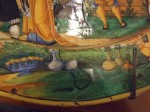 It’s the condition and quality of the painting that made the market salivate. The dish is nearly 500 years old, but the colors are still brilliant and the finish glossy. The only damage was a repaired chip about 1.4 inches wide on the bottom of the charger. It’s barely noticeable and doesn’t overlap with any of the figures, just with the yellow border and a green scribble of grass.
It’s the condition and quality of the painting that made the market salivate. The dish is nearly 500 years old, but the colors are still brilliant and the finish glossy. The only damage was a repaired chip about 1.4 inches wide on the bottom of the charger. It’s barely noticeable and doesn’t overlap with any of the figures, just with the yellow border and a green scribble of grass.
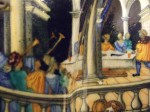 The plate is 16 inches in diameter and painted in a style called istoriato, an elaborate, highly detailed scene from history or legend. The subject on this piece is the Feast of Herod, although it takes a little looking to see it. Herod and his wife sit at a table under the columned portico in the left background. Walking up the steps towards them is Salome and some ladies
The plate is 16 inches in diameter and painted in a style called istoriato, an elaborate, highly detailed scene from history or legend. The subject on this piece is the Feast of Herod, although it takes a little looking to see it. Herod and his wife sit at a table under the columned portico in the left background. Walking up the steps towards them is Salome and some ladies 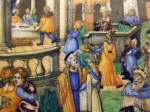 carrying the head of John the Baptist on a platter. In the center background between the upper tree trunk on the left and the riverbank on the right is the executioner standing next to John’s headless body.
carrying the head of John the Baptist on a platter. In the center background between the upper tree trunk on the left and the riverbank on the right is the executioner standing next to John’s headless body.
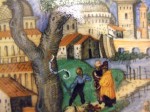 The rest of the scene is populated by wealthy revelers banqueting front and center, musicians to the left of them, ladies dancing to the left of the musicians, skinny dippers in the river on the right and a townscape in the back. It’s a big ol’ Renaissance party that could be set in any hilly town in Europe. One extra special touch is a hint of what may be the painter’s name hidden in the fur stole of the woman sitting on the right side of the central foreground banqueting table.
The rest of the scene is populated by wealthy revelers banqueting front and center, musicians to the left of them, ladies dancing to the left of the musicians, skinny dippers in the river on the right and a townscape in the back. It’s a big ol’ Renaissance party that could be set in any hilly town in Europe. One extra special touch is a hint of what may be the painter’s name hidden in the fur stole of the woman sitting on the right side of the central foreground banqueting table.
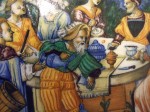
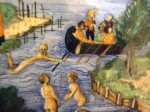
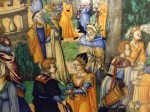
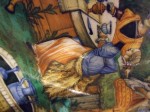
The design is a version of The Feast of Herod, a woodcut by German printmaker Sebald Beham dating to 1525-1545. The maiolica version leaves 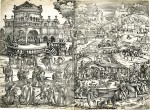 out the figure of death of holding a scythe who follows a couple walking just beneath Salome and John’s head. The architecture and overall scene is compressed to fit onto a plate, but other than those changes and the marvelous addition of color, it’s a faithful rendition.
out the figure of death of holding a scythe who follows a couple walking just beneath Salome and John’s head. The architecture and overall scene is compressed to fit onto a plate, but other than those changes and the marvelous addition of color, it’s a faithful rendition.
No wonder that it claimed one of the highest prices ever paid for Italian pottery. The lucky buyer was London jewelery dealer S.J. Phillips Ltd. Company director Francis Norton said: “The plate is in wonderful condition and we really fancied it and were determined to get it. We don’t know what we’ll do with it yet but we might put it on display.”